Target Information
| Target General Information | Top | |||||
|---|---|---|---|---|---|---|
| Target ID |
T62460
(Former ID: TTDNS00611)
|
|||||
| Target Name |
Janus kinase 1 (JAK-1)
|
|||||
| Synonyms |
Tyrosine-protein kinase JAK1; JAK1B; JAK1A
Click to Show/Hide
|
|||||
| Gene Name |
JAK1
|
|||||
| Target Type |
Successful target
|
[1] | ||||
| Disease | [+] 4 Target-related Diseases | + | ||||
| 1 | Atopic eczema [ICD-11: EA80] | |||||
| 2 | Myeloproliferative neoplasm [ICD-11: 2A20] | |||||
| 3 | Rheumatoid arthritis [ICD-11: FA20] | |||||
| 4 | Thrombocytosis [ICD-11: 3B63] | |||||
| Function |
Kinase partner for the interleukin (IL)-2 receptor as well as interleukin (IL)-10 receptor. Tyrosine kinase of the non-receptor type, involved in the IFN-alpha/beta/gamma signal pathway.
Click to Show/Hide
|
|||||
| BioChemical Class |
Kinase
|
|||||
| UniProt ID | ||||||
| EC Number |
EC 2.7.10.2
|
|||||
| Sequence |
MQYLNIKEDCNAMAFCAKMRSSKKTEVNLEAPEPGVEVIFYLSDREPLRLGSGEYTAEEL
CIRAAQACRISPLCHNLFALYDENTKLWYAPNRTITVDDKMSLRLHYRMRFYFTNWHGTN DNEQSVWRHSPKKQKNGYEKKKIPDATPLLDASSLEYLFAQGQYDLVKCLAPIRDPKTEQ DGHDIENECLGMAVLAISHYAMMKKMQLPELPKDISYKRYIPETLNKSIRQRNLLTRMRI NNVFKDFLKEFNNKTICDSSVSTHDLKVKYLATLETLTKHYGAEIFETSMLLISSENEMN WFHSNDGGNVLYYEVMVTGNLGIQWRHKPNVVSVEKEKNKLKRKKLENKHKKDEEKNKIR EEWNNFSYFPEITHIVIKESVVSINKQDNKKMELKLSSHEEALSFVSLVDGYFRLTADAH HYLCTDVAPPLIVHNIQNGCHGPICTEYAINKLRQEGSEEGMYVLRWSCTDFDNILMTVT CFEKSEQVQGAQKQFKNFQIEVQKGRYSLHGSDRSFPSLGDLMSHLKKQILRTDNISFML KRCCQPKPREISNLLVATKKAQEWQPVYPMSQLSFDRILKKDLVQGEHLGRGTRTHIYSG TLMDYKDDEGTSEEKKIKVILKVLDPSHRDISLAFFEAASMMRQVSHKHIVYLYGVCVRD VENIMVEEFVEGGPLDLFMHRKSDVLTTPWKFKVAKQLASALSYLEDKDLVHGNVCTKNL LLAREGIDSECGPFIKLSDPGIPITVLSRQECIERIPWIAPECVEDSKNLSVAADKWSFG TTLWEICYNGEIPLKDKTLIEKERFYESRCRPVTPSCKELADLMTRCMNYDPNQRPFFRA IMRDINKLEEQNPDIVSEKKPATEVDPTHFEKRFLKRIRDLGEGHFGKVELCRYDPEGDN TGEQVAVKSLKPESGGNHIADLKKEIEILRNLYHENIVKYKGICTEDGGNGIKLIMEFLP SGSLKEYLPKNKNKINLKQQLKYAVQICKGMDYLGSRQYVHRDLAARNVLVESEHQVKIG DFGLTKAIETDKEYYTVKDDRDSPVFWYAPECLMQSKFYIASDVWSFGVTLHELLTYCDS DSSPMALFLKMIGPTHGQMTVTRLVNTLKEGKRLPCPPNCPDEVYQLMRKCWEFQPSNRT SFQNLIEGFEALLK Click to Show/Hide
|
|||||
| 3D Structure | Click to Show 3D Structure of This Target | AlphaFold | ||||
| HIT2.0 ID | T22J9V | |||||
| Drugs and Modes of Action | Top | |||||
|---|---|---|---|---|---|---|
| Approved Drug(s) | [+] 3 Approved Drugs | + | ||||
| 1 | Abrocitinib | Drug Info | Approved | Atopic dermatitis | [7] | |
| 2 | Momelotinib | Drug Info | Approved | Myelofibrosis | [8] | |
| 3 | Upadacitinib | Drug Info | Approved | Rheumatoid arthritis | [9] | |
| Clinical Trial Drug(s) | [+] 7 Clinical Trial Drugs | + | ||||
| 1 | ASP-015K | Drug Info | Phase 3 | Psoriasis vulgaris | [11], [12] | |
| 2 | Cerdulatinib | Drug Info | Phase 2 | B-cell lymphoma | [20] | |
| 3 | CTP-543 | Drug Info | Phase 2 | Asthma | [21], [13] | |
| 4 | GLPG-0634 | Drug Info | Phase 2 | Rheumatoid arthritis | [22], [23] | |
| 5 | GSK2586184 | Drug Info | Phase 2 | Systemic lupus erythematosus | [24] | |
| 6 | INCB039110 | Drug Info | Phase 2 | Malignant neoplasm | [25] | |
| 7 | INCB54707 | Drug Info | Phase 2 | Hidradenitis suppurativa | [13] | |
| Discontinued Drug(s) | [+] 1 Discontinued Drugs | + | ||||
| 1 | INCB47986 | Drug Info | Discontinued in Phase 2 | Rheumatoid arthritis | [32] | |
| Mode of Action | [+] 2 Modes of Action | + | ||||
| Inhibitor | [+] 54 Inhibitor drugs | + | ||||
| 1 | Abrocitinib | Drug Info | [7] | |||
| 2 | ASP-015K | Drug Info | [33] | |||
| 3 | Cerdulatinib | Drug Info | [13] | |||
| 4 | CTP-543 | Drug Info | [21] | |||
| 5 | INCB039110 | Drug Info | [33] | |||
| 6 | INCB54707 | Drug Info | [13] | |||
| 7 | Aminooxazole carboxamide derivative 1 | Drug Info | [37] | |||
| 8 | Aminotriazolopyridine derivative 1 | Drug Info | [38] | |||
| 9 | Benzimidazole derivative 7 | Drug Info | [38] | |||
| 10 | Bipyrazole derivative 1 | Drug Info | [38] | |||
| 11 | Bis-aminopyrimidine derivative 1 | Drug Info | [38] | |||
| 12 | Bis-aminopyrimidine derivative 2 | Drug Info | [38] | |||
| 13 | Bis-aminopyrimidine derivative 3 | Drug Info | [38] | |||
| 14 | Bis-aminopyrimidine derivative 4 | Drug Info | [38] | |||
| 15 | Cyanomethyl pypazole carboxamide derivative 1 | Drug Info | [37] | |||
| 16 | Cyclic cyanoethypypazole derivative 1 | Drug Info | [37] | |||
| 17 | Cycloalkyl nitrile pyrazolo pyridone derivative 1 | Drug Info | [37] | |||
| 18 | Cycloalkyl nitrile pyrazolo pyridone derivative 2 | Drug Info | [37] | |||
| 19 | Cyclohexyl azetidine derivative 1 | Drug Info | [38] | |||
| 20 | Five-and-six-membered heterocyclic compound 1 | Drug Info | [37] | |||
| 21 | Geminally-substituted cyanoethylpypazolo pyridone derivative 1 | Drug Info | [37] | |||
| 22 | Geminally-substituted cyanoethylpypazolo pyridone derivative 2 | Drug Info | [37] | |||
| 23 | Imidazopyridazine derivative 1 | Drug Info | [38] | |||
| 24 | Imidazopyridazine derivative 2 | Drug Info | [38] | |||
| 25 | Imidazo[4,5-c]pyridine derivative 1 | Drug Info | [38] | |||
| 26 | Isoxazole derivative 1 | Drug Info | [37] | |||
| 27 | Isoxazole derivative 2 | Drug Info | [37] | |||
| 28 | PMID27774822-Compound-Figure11Example5 | Drug Info | [37] | |||
| 29 | PMID27774822-Compound-Figure1Example20 | Drug Info | [37] | |||
| 30 | PMID27774822-Compound-Figure7Example63 | Drug Info | [37] | |||
| 31 | PMID27774824-Compound-Figure2Example4 | Drug Info | [38] | |||
| 32 | PMID27774824-Compound-Figure3Example18 | Drug Info | [38] | |||
| 33 | PMID27774824-Compound-Figure6Example12 | Drug Info | [38] | |||
| 34 | PMID27774824-Compound-Figure6Example6 | Drug Info | [38] | |||
| 35 | PMID27774824-Compound-Figure7Example10 | Drug Info | [38] | |||
| 36 | PMID27774824-Compound-Figure9Example2down | Drug Info | [38] | |||
| 37 | Pyrazolopyridine derivative 3 | Drug Info | [37] | |||
| 38 | Pyrazolopyridine derivative 4 | Drug Info | [37] | |||
| 39 | Pyrazolo[4,3-c]pyridine derivative 2 | Drug Info | [38] | |||
| 40 | Pyrrole six-membered heteroaryl ring derivative 1 | Drug Info | [37] | |||
| 41 | Pyrrolo-pyridone derivative 1 | Drug Info | [37] | |||
| 42 | Pyrrolo-pyridone derivative 2 | Drug Info | [37] | |||
| 43 | Pyrrolo-pyridone derivative 3 | Drug Info | [37] | |||
| 44 | Pyrrolo[2,3-d]pyrimidine derivative 6 | Drug Info | [37] | |||
| 45 | Pyrrolo[2,3-d]pyrimidine derivative 8 | Drug Info | [37] | |||
| 46 | Ruxolitinib derivative 2 | Drug Info | [38] | |||
| 47 | Triazolo-pyridine derivative 1 | Drug Info | [37] | |||
| 48 | Tricyclic compound 1 | Drug Info | [38] | |||
| 49 | Tricyclic compound 11 | Drug Info | [37] | |||
| 50 | Tricyclic compound 3 | Drug Info | [38] | |||
| 51 | Tricyclic heterocycle derivative 5 | Drug Info | [37] | |||
| 52 | Tricyclic pyrrolopyridine compound 1 | Drug Info | [37] | |||
| 53 | INCB47986 | Drug Info | [34] | |||
| 54 | WHI-P154 | Drug Info | [39] | |||
| Modulator | [+] 4 Modulator drugs | + | ||||
| 1 | Momelotinib | Drug Info | [8] | |||
| 2 | Upadacitinib | Drug Info | [9] | |||
| 3 | GLPG-0634 | Drug Info | [34], [35] | |||
| 4 | GSK2586184 | Drug Info | [36] | |||
| Cell-based Target Expression Variations | Top | |||||
|---|---|---|---|---|---|---|
| Cell-based Target Expression Variations | ||||||
| Drug Binding Sites of Target | Top | |||||
|---|---|---|---|---|---|---|
| Ligand Name: Tofacitinib | Ligand Info | |||||
| Structure Description | Crystal structures of JAK1 and JAK2 inhibitor complexes | PDB:3EYG | ||||
| Method | X-ray diffraction | Resolution | 1.90 Å | Mutation | No | [40] |
| PDB Sequence |
VDPTHFEKRF
874 LKRIRDLGEG884 HFGKVELCRY894 DPEGDNTGEQ904 VAVKSLKPHI919 ADLKKEIEIL 929 RNLYHENIVK939 YKGICTENGI952 KLIMEFLPSG962 SLKEYLPKNK972 NKINLKQQLK 982 YAVQICKGMD992 YLGSRQYVHR1002 DLAARNVLVE1012 SEHQVKIGDF1022 GLTKAIETDK 1032 ETVKDDRDSP1044 VFWYAPECLM1054 QSKFYIASDV1064 WSFGVTLHEL1074 LTYCDSDSSP 1084 MALFLKMIGP1094 THGQMTVTRL1104 VNTLKEGKRL1114 PCPPNCPDEV1124 YQLMRKCWEF 1134 QPSNRTSFQN1144 LIEGFEALLK1154
|
|||||
|
|
LEU881
3.536
GLY882
3.199
GLU883
3.364
GLY884
2.866
HIS885
4.598
GLY887
3.122
LYS888
3.900
VAL889
3.146
ALA906
3.213
LYS908
3.395
VAL938
4.070
MET956
3.822
|
|||||
| Ligand Name: PF-04965842 | Ligand Info | |||||
| Structure Description | Crystal Structure of JAK1 in complex with compound 25 | PDB:6BBU | ||||
| Method | X-ray diffraction | Resolution | 2.08 Å | Mutation | No | [41] |
| PDB Sequence |
PTHFEKRFLK
876 RIRDLGEGHF886 GKVELCRYDP896 EGDNTGEQVA906 VKSLKPNHIA920 DLKKEIEILR 930 NLYHENIVKY940 KGICTENGIK953 LIMEFLPSGS963 LKEYLPKNKN973 KINLKQQLKY 983 AVQICKGMDY993 LGSRQYVHRD1003 LAARNVLVES1013 EHQVKIGDFG1023 LTKAIETDKE 1033 TVKDDRDSPV1045 FWYAPECLMQ1055 SKFYIASDVW1065 SFGVTLHELL1075 TYCDSDSSPM 1085 ALFLKMIGPT1095 HGQMTVTRLV1105 NTLKEGKRLP1115 CPPNCPDEVY1125 QLMRKCWEFQ 1135 PSNRTSFQNL1145 IEGFEALLK
|
|||||
|
|
LEU881
2.653
GLY882
3.251
GLU883
2.812
GLY884
2.901
GLY887
3.122
LYS888
3.558
VAL889
3.071
ALA906
3.343
LYS908
2.820
VAL938
3.527
MET956
2.965
GLU957
1.817
|
|||||
| Click to View More Binding Site Information of This Target with Different Ligands | ||||||
| Different Human System Profiles of Target | Top |
|---|---|
|
Human Similarity Proteins
of target is determined by comparing the sequence similarity of all human proteins with the target based on BLAST. The similarity proteins for a target are defined as the proteins with E-value < 0.005 and outside the protein families of the target.
A target that has fewer human similarity proteins outside its family is commonly regarded to possess a greater capacity to avoid undesired interactions and thus increase the possibility of finding successful drugs
(Brief Bioinform, 21: 649-662, 2020).
Human Tissue Distribution
of target is determined from a proteomics study that quantified more than 12,000 genes across 32 normal human tissues. Tissue Specificity (TS) score was used to define the enrichment of target across tissues.
The distribution of targets among different tissues or organs need to be taken into consideration when assessing the target druggability, as it is generally accepted that the wider the target distribution, the greater the concern over potential adverse effects
(Nat Rev Drug Discov, 20: 64-81, 2021).
Human Pathway Affiliation
of target is determined by the life-essential pathways provided on KEGG database. The target-affiliated pathways were defined based on the following two criteria (a) the pathways of the studied target should be life-essential for both healthy individuals and patients, and (b) the studied target should occupy an upstream position in the pathways and therefore had the ability to regulate biological function.
Targets involved in a fewer pathways have greater likelihood to be successfully developed, while those associated with more human pathways increase the chance of undesirable interferences with other human processes
(Pharmacol Rev, 58: 259-279, 2006).
Biological Network Descriptors
of target is determined based on a human protein-protein interactions (PPI) network consisting of 9,309 proteins and 52,713 PPIs, which were with a high confidence score of ≥ 0.95 collected from STRING database.
The network properties of targets based on protein-protein interactions (PPIs) have been widely adopted for the assessment of target’s druggability. Proteins with high node degree tend to have a high impact on network function through multiple interactions, while proteins with high betweenness centrality are regarded to be central for communication in interaction networks and regulate the flow of signaling information
(Front Pharmacol, 9, 1245, 2018;
Curr Opin Struct Biol. 44:134-142, 2017).
Human Similarity Proteins
Human Tissue Distribution
Human Pathway Affiliation
Biological Network Descriptors
|
|
|
Note:
If a protein has TS (tissue specficity) scores at least in one tissue >= 2.5, this protein is called tissue-enriched (including tissue-enriched-but-not-specific and tissue-specific). In the plots, the vertical lines are at thresholds 2.5 and 4.
|
| KEGG Pathway | Pathway ID | Affiliated Target | Pathway Map |
|---|---|---|---|
| PI3K-Akt signaling pathway | hsa04151 | Affiliated Target |
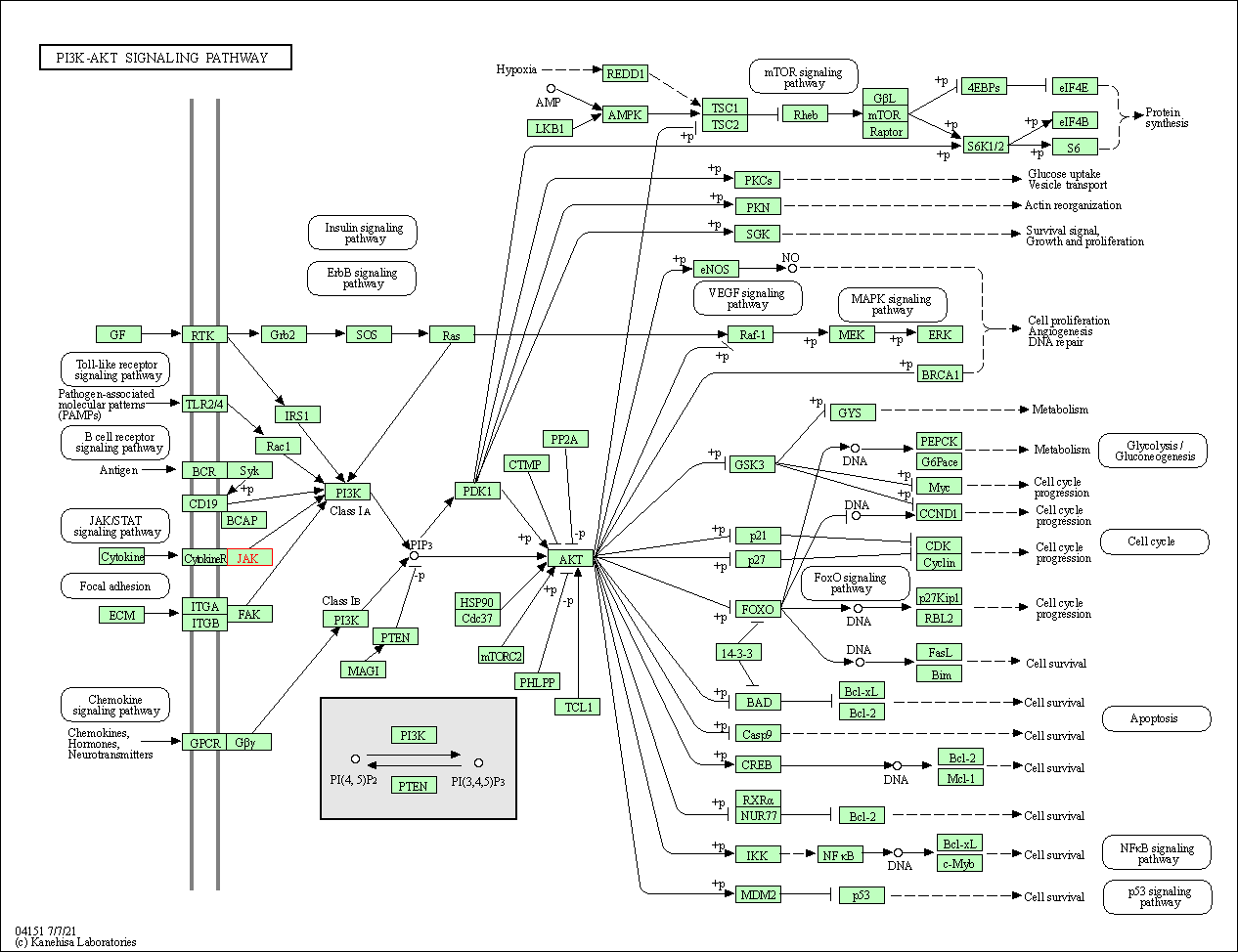
|
| Class: Environmental Information Processing => Signal transduction | Pathway Hierarchy | ||
| Necroptosis | hsa04217 | Affiliated Target |

|
| Class: Cellular Processes => Cell growth and death | Pathway Hierarchy | ||
| Osteoclast differentiation | hsa04380 | Affiliated Target |
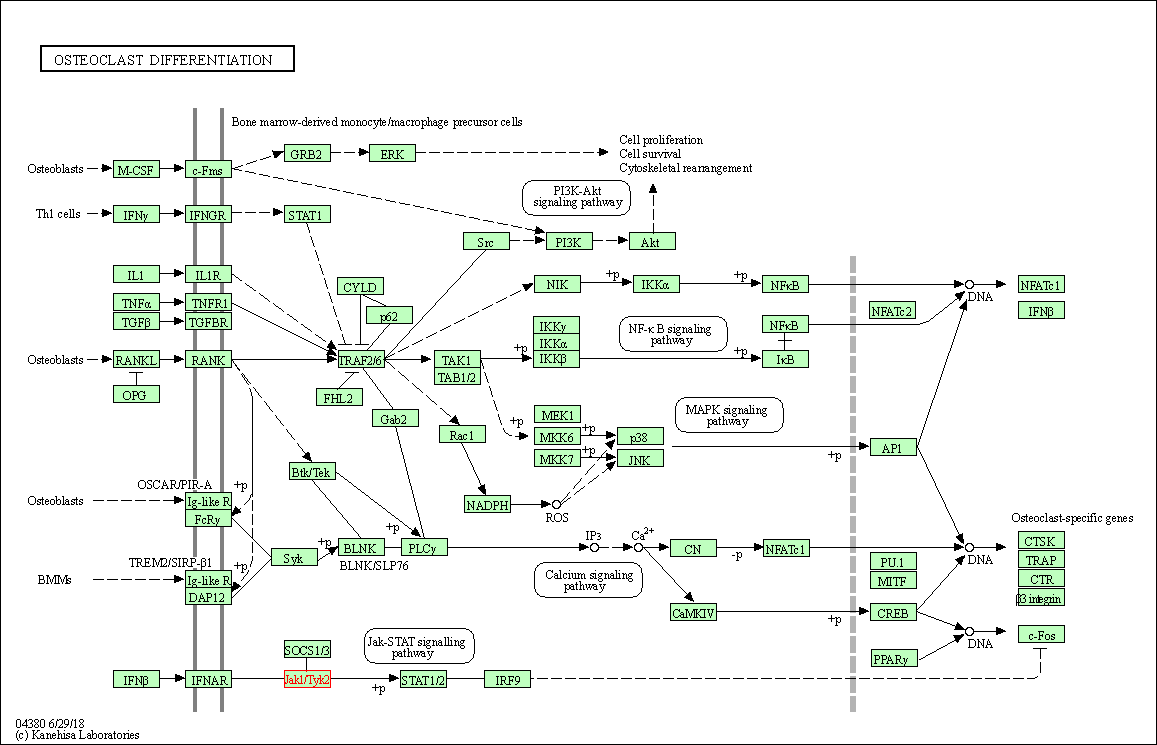
|
| Class: Organismal Systems => Development and regeneration | Pathway Hierarchy | ||
| Signaling pathways regulating pluripotency of stem cells | hsa04550 | Affiliated Target |

|
| Class: Cellular Processes => Cellular community - eukaryotes | Pathway Hierarchy | ||
| NOD-like receptor signaling pathway | hsa04621 | Affiliated Target |

|
| Class: Organismal Systems => Immune system | Pathway Hierarchy | ||
| JAK-STAT signaling pathway | hsa04630 | Affiliated Target |
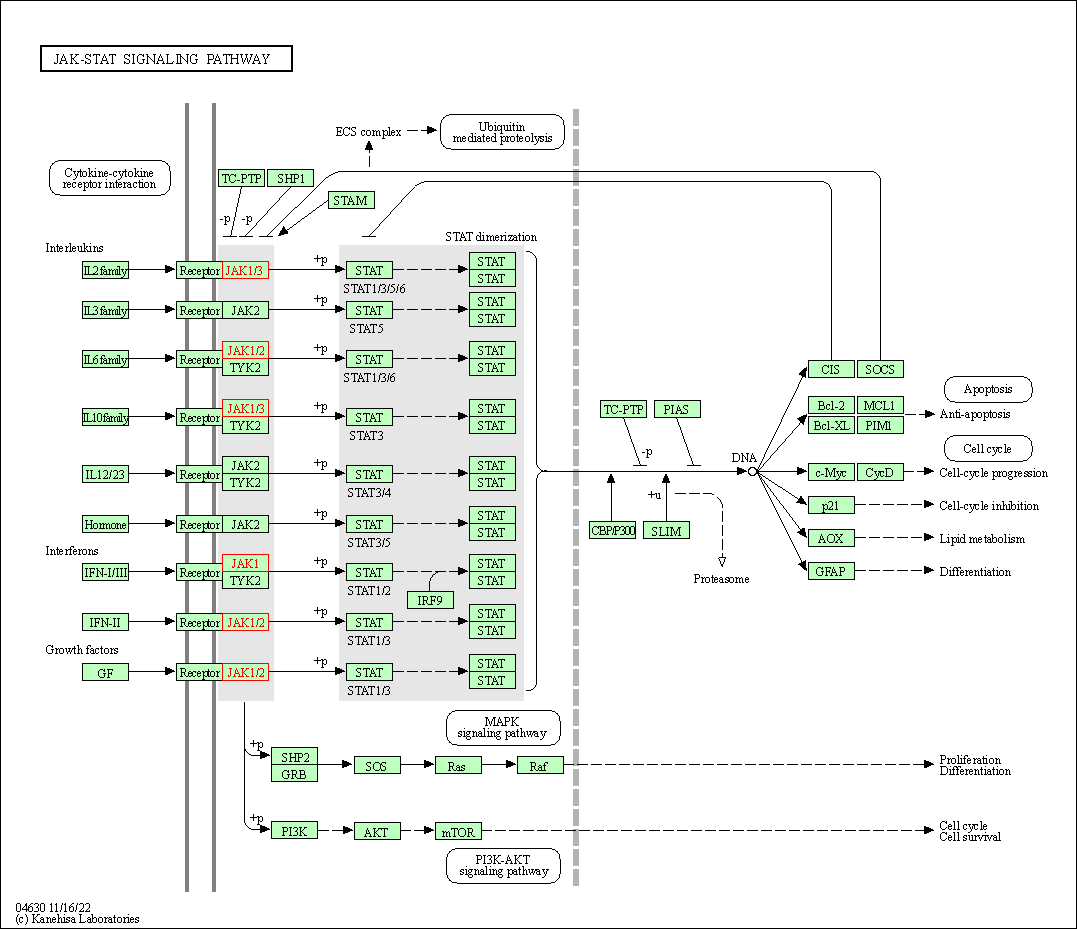
|
| Class: Environmental Information Processing => Signal transduction | Pathway Hierarchy | ||
| Th1 and Th2 cell differentiation | hsa04658 | Affiliated Target |
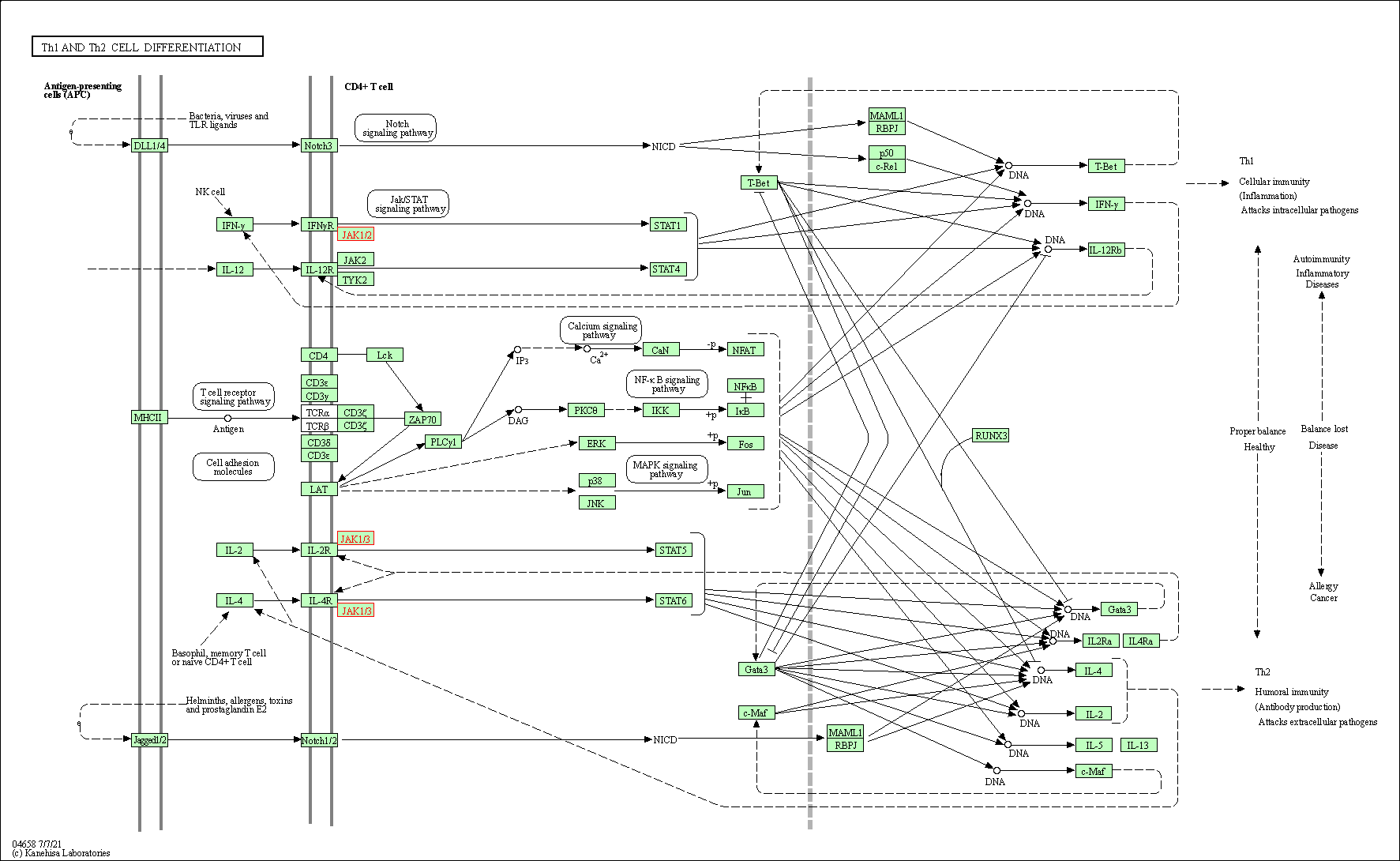
|
| Class: Organismal Systems => Immune system | Pathway Hierarchy | ||
| Th17 cell differentiation | hsa04659 | Affiliated Target |
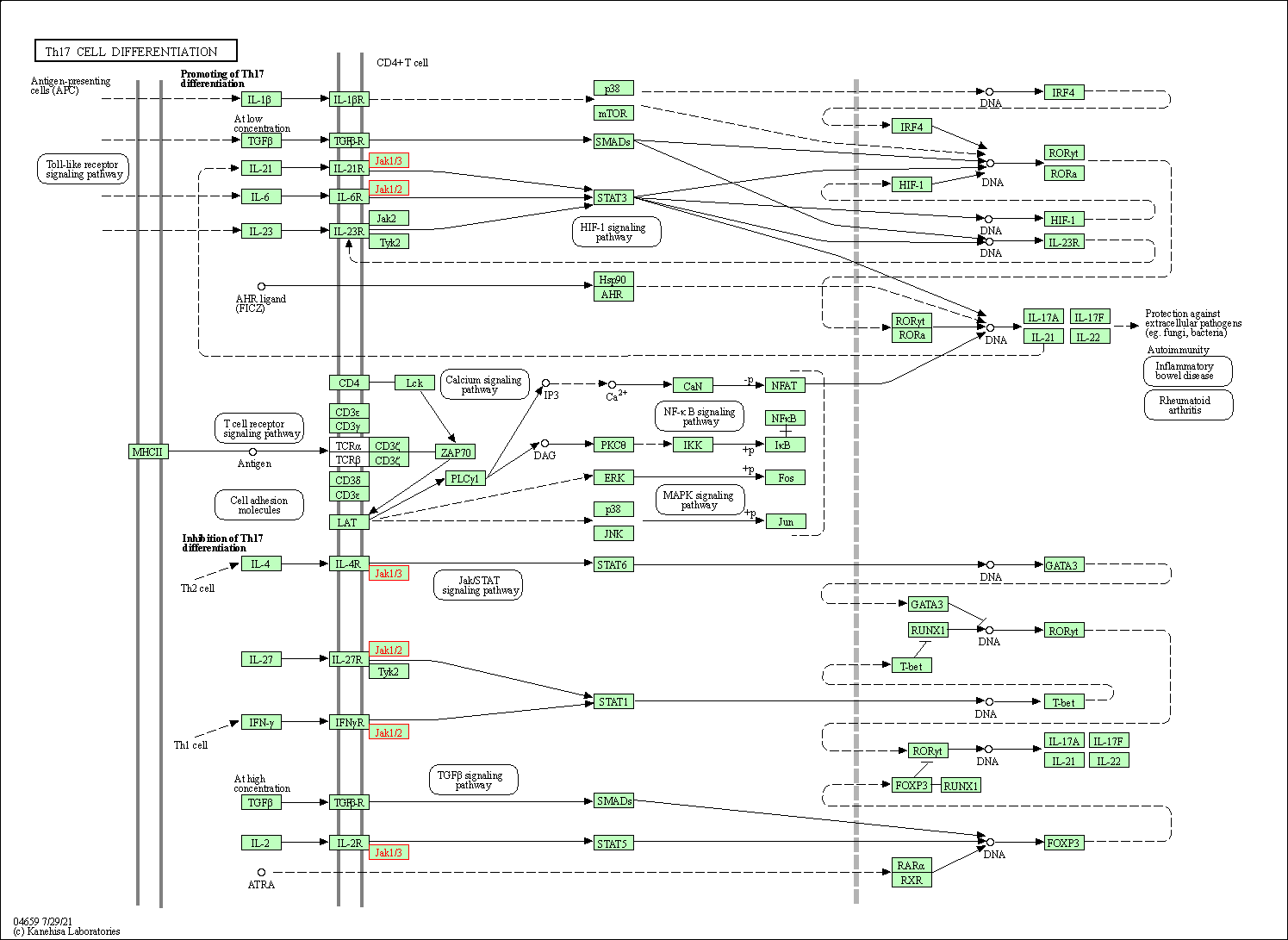
|
| Class: Organismal Systems => Immune system | Pathway Hierarchy | ||
| Click to Show/Hide the Information of Affiliated Human Pathways | |||
| Degree | 50 | Degree centrality | 5.37E-03 | Betweenness centrality | 2.00E-03 |
|---|---|---|---|---|---|
| Closeness centrality | 2.41E-01 | Radiality | 1.42E+01 | Clustering coefficient | 1.27E-01 |
| Neighborhood connectivity | 3.00E+01 | Topological coefficient | 5.76E-02 | Eccentricity | 12 |
| Download | Click to Download the Full PPI Network of This Target | ||||
| Chemical Structure based Activity Landscape of Target | Top |
|---|---|
| Drug Property Profile of Target | Top | |
|---|---|---|
| (1) Molecular Weight (mw) based Drug Clustering | (2) Octanol/Water Partition Coefficient (xlogp) based Drug Clustering | |
|
|
||
| (3) Hydrogen Bond Donor Count (hbonddonor) based Drug Clustering | (4) Hydrogen Bond Acceptor Count (hbondacc) based Drug Clustering | |
|
|
||
| (5) Rotatable Bond Count (rotbonds) based Drug Clustering | (6) Topological Polar Surface Area (polararea) based Drug Clustering | |
|
|
||
| "RO5" indicates the cutoff set by lipinski's rule of five; "D123AB" colored in GREEN denotes the no violation of any cutoff in lipinski's rule of five; "D123AB" colored in PURPLE refers to the violation of only one cutoff in lipinski's rule of five; "D123AB" colored in BLACK represents the violation of more than one cutoffs in lipinski's rule of five | ||
| Co-Targets | Top | |||||
|---|---|---|---|---|---|---|
| Co-Targets | ||||||
| Target Poor or Non Binders | Top | |||||
|---|---|---|---|---|---|---|
| Target Poor or Non Binders | ||||||
| Target Regulators | Top | |||||
|---|---|---|---|---|---|---|
| Target-regulating microRNAs | ||||||
| Target-interacting Proteins | ||||||
| Target Profiles in Patients | Top | |||||
|---|---|---|---|---|---|---|
| Target Expression Profile (TEP) | ||||||
| References | Top | |||||
|---|---|---|---|---|---|---|
| REF 1 | 2011 FDA drug approvals. Nat Rev Drug Discov. 2012 Feb 1;11(2):91-4. | |||||
| REF 2 | URL: http://www.guidetopharmacology.org Nucleic Acids Res. 2015 Oct 12. pii: gkv1037. The IUPHAR/BPS Guide to PHARMACOLOGY in 2016: towards curated quantitative interactions between 1300 protein targets and 6000 ligands. (Ligand id: 5688). | |||||
| REF 3 | ClinicalTrials.gov (NCT02038036) Ruxolitinib Efficacy and Safety in Patients With HU Resistant or Intolerant Polycythemia Vera vs Best Available Therapy.. U.S. National Institutes of Health. | |||||
| REF 4 | Ruxolitinib versus standard therapy for the treatment of polycythemia vera. N Engl J Med. 2015 Jan 29;372(5):426-35. | |||||
| REF 5 | Drugs@FDA. U.S. Food and Drug Administration. U.S. Department of Health & Human Services. | |||||
| REF 6 | 2018 FDA drug approvals.Nat Rev Drug Discov. 2019 Feb;18(2):85-89. | |||||
| REF 7 | FDA Approved Drug Products from FDA Official Website. 2023. Application Number: 213871. | |||||
| REF 8 | FDA Approved Drug Products from FDA Official Website. 2023. Application Number: 216873 | |||||
| REF 9 | Drugs@FDA. U.S. Food and Drug Administration. U.S. Department of Health Human Services. 2019 | |||||
| REF 10 | ClinicalTrials.gov (NCT05181137) A Phase 3 Study to Evaluate the Efficacy and Long-term Safety of SHR0302 Therapy in Subjects With Moderately to Severely Active Ulcerative Colitis. U.S.National Institutes of Health. | |||||
| REF 11 | URL: http://www.guidetopharmacology.org Nucleic Acids Res. 2015 Oct 12. pii: gkv1037. The IUPHAR/BPS Guide to PHARMACOLOGY in 2016: towards curated quantitative interactions between 1300 protein targets and 6000 ligands. (Ligand id: 8315). | |||||
| REF 12 | ClinicalTrials.gov (NCT02308163) A Study to Evaluate Safety and Efficacy of ASP015K in Patients With Rheumatoid Arthritis (RA) Who Had an Inadequate Response to DMARDs. U.S. National Institutes of Health. | |||||
| REF 13 | Clinical pipeline report, company report or official report of the Pharmaceutical Research and Manufacturers of America (PhRMA) | |||||
| REF 14 | ClinicalTrials.gov (NCT03898479) Extension Study to Evaluate Safety and Efficacy of CTP-543 in Adults With Alopecia Areata. U.S. National Institutes of Health. | |||||
| REF 15 | ClinicalTrials.gov (NCT03759340) ATI-502 Topical Solution for the Treatment of Alopecia Areata (AA), Alopecia Universalis (AU) and Alopecia Totalis (AT). U.S. National Institutes of Health. | |||||
| REF 16 | ClinicalTrials.gov (NCT03594227) ATI-501 Oral Suspension Compared to Placebo in Subjects With Alopecia Areata, Alopecia Universalis or Alopecia Totalis. U.S. National Institutes of Health. | |||||
| REF 17 | ClinicalTrials.gov (NCT04150341) A Randomized, Double-blind, Placebo-controlled, 3-period Crossover Study to Evaluate the Effects of Repeated Doses of Inhaled TD-8236 and Impact on Airway Responses Following Allergen Challenge in Patients With Asthma. U.S.National Institutes of Health. | |||||
| REF 18 | Clinical pipeline report, company report or official report of EQRx | |||||
| REF 19 | Clinical pipeline report, company report or official report of Klus Pharma | |||||
| REF 20 | Clinical pipeline report, company report or official report of the Pharmaceutical Research and Manufacturers of America (PhRMA) | |||||
| REF 21 | Clinical pipeline report, company report or official report of the Pharmaceutical Research and Manufacturers of America (PhRMA) | |||||
| REF 22 | URL: http://www.guidetopharmacology.org Nucleic Acids Res. 2015 Oct 12. pii: gkv1037. The IUPHAR/BPS Guide to PHARMACOLOGY in 2016: towards curated quantitative interactions between 1300 protein targets and 6000 ligands. (Ligand id: 7913). | |||||
| REF 23 | ClinicalTrials.gov (NCT02048618) Efficacy and Safety of GLPG0634 in Subjects With Active Crohn's Disease. U.S. National Institutes of Health. | |||||
| REF 24 | ClinicalTrials.gov (NCT01777256) An Adaptive Phase II Study to Evaluate the Efficacy, Pharmacodynamics, Safety and Tolerability of GSK2586184. U.S. National Institutes of Health. | |||||
| REF 25 | URL: http://www.guidetopharmacology.org Nucleic Acids Res. 2015 Oct 12. pii: gkv1037. The IUPHAR/BPS Guide to PHARMACOLOGY in 2016: towards curated quantitative interactions between 1300 protein targets and 6000 ligands. (Ligand id: 8364). | |||||
| REF 26 | ClinicalTrials.gov (NCT01994382) A Phase 1/2a Open-Label, Multi-Dose, Multi-Center Escalation and Exploratory Study of Cerdulatinib (PRT062070) in Patients With Relapsed/Refractory Chronic Lymphocytic Leukemia (CLL)/Small Lymphocytic Lymphoma (SLL) or B-Cell or T-Cell Non-Hodgkin Lymphoma (NHL). U.S.National Institutes of Health. | |||||
| REF 27 | Inhaled JAK inhibitor GDC-0214 reduces exhaled nitric oxide in patients with mild asthma: A?randomized, controlled, proof-of-activity trial. J Allergy Clin Immunol. 2021 Sep;148(3):783-789. | |||||
| REF 28 | ClinicalTrials.gov (NCT03766399) A Single-blind, Randomized, Placebo-Controlled 3-Part Study in Healthy Volunteers and Patients With Mild Asthma to Investigate the Safety, Tolerability and Pharmacokinetics of Inhaled AZD0449 Following Single and Multiple Ascending Doses and to Investigate the Anti-Inflammatory Effect of Inhaled AZD0449. U.S.National Institutes of Health. | |||||
| REF 29 | ClinicalTrials.gov (NCT05206604) A PHASE 1, RANDOMIZED, DOUBLE-BLIND, SPONSOR-OPEN, VEHICLE-CONTROLLED, FIRST-IN-HUMAN, MULTIPLE-DOSE STUDY, TO INVESTIGATE THE SAFETY, TOLERABILITY, AND PHARMACOKINETICS, OF TOPICALLY ADMINISTERED PF-07295324 AND PF-07259955, IN HEALTHY ADULT PARTICIPANTS. U.S.National Institutes of Health. | |||||
| REF 30 | ClinicalTrials.gov (NCT04769869) A Single-blind, Randomized, Placebo-controlled 3 Part Study in Healthy Volunteers and Patients With Mild Asthma to Investigate the Safety, Tolerability, and Pharmacokinetics of Inhaled AZD4604 Following Single and Multiple Ascending Doses and to Investigate the Anti-inflammatory Effect of Inhaled AZD4604. U.S.National Institutes of Health. | |||||
| REF 31 | ClinicalTrials.gov (NCT05006521) Phase 1 Randomized, Double-Blind, Placebo-Controlled Study to Evaluate the Safety, PK, and PD of Single Ascending Doses of KN-002 in Healthy Subjects and Multiple Ascending Doses of KN-002 in Subjects With Mild Asthma, Moderate-Severe Asthma and COPD. U.S.National Institutes of Health. | |||||
| REF 32 | Trusted, scientifically sound profiles of drug programs, clinical trials, safety reports, and company deals, written by scientists. Springer. 2015. Adis Insight (drug id 800038032) | |||||
| REF 33 | URL: http://www.guidetopharmacology.org Nucleic Acids Res. 2015 Oct 12. pii: gkv1037. The IUPHAR/BPS Guide to PHARMACOLOGY in 2016: towards curated quantitative interactions between 1300 protein targets and 6000 ligands. (Target id: 2047). | |||||
| REF 34 | Selective JAK inhibitors in development for rheumatoid arthritis. Expert Opin Investig Drugs. 2014 Aug;23(8):1067-77. | |||||
| REF 35 | Preclinical characterization of GLPG0634, a selective inhibitor of JAK1, for the treatment of inflammatory diseases. J Immunol. 2013 Oct 1;191(7):3568-77. | |||||
| REF 36 | DRESS syndrome and reversible liver function abnormalities in patients with systemic lupus erythematosus treated with the highly selective JAK-1 inhibitor GSK2586184. Lupus. 2015 May;24(6):648-9. | |||||
| REF 37 | Inhibitors of JAK-family kinases: an update on the patent literature 2013-2015, part 2.Expert Opin Ther Pat. 2017 Feb;27(2):145-161. | |||||
| REF 38 | Inhibitors of JAK-family kinases: an update on the patent literature 2013-2015, part 1.Expert Opin Ther Pat. 2017 Feb;27(2):127-143. | |||||
| REF 39 | The specificity of JAK3 kinase inhibitors. Blood. 2008 Feb 15;111(4):2155-7. | |||||
| REF 40 | Dissecting specificity in the Janus kinases: the structures of JAK-specific inhibitors complexed to the JAK1 and JAK2 protein tyrosine kinase domains. J Mol Biol. 2009 Mar 20;387(1):219-32. | |||||
| REF 41 | Identification of N-{cis-3-[Methyl(7H-pyrrolo[2,3-d]pyrimidin-4-yl)amino]cyclobutyl}propane-1-sulfonamide (PF-04965842): A Selective JAK1 Clinical Candidate for the Treatment of Autoimmune Diseases. J Med Chem. 2018 Feb 8;61(3):1130-1152. | |||||
If You Find Any Error in Data or Bug in Web Service, Please Kindly Report It to Dr. Zhou and Dr. Zhang.

